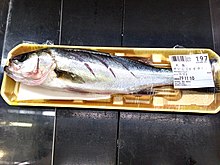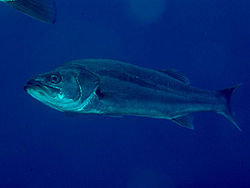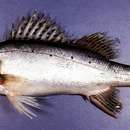Trophic Strategy
(
Inglês
)
fornecido por Fishbase
Found in moving water of inshore rocky reefs (Ref. 12497); also from coral reefs (Ref. 58534). Juveniles may ascend rivers. Spawning occurs during winter, in deeper rocky reefs. Predaceous, feeding on zooplankton at an early age and on small fish and shrimps as adults (Ref. 12497). Fish >6.0 cm SL were piscivorous (Ref. 49776). Larval migration to better foraging grounds with higher prey biomass, elevated temperature and reduced salinity may reduce early mortality and attain a better condition. Utilization of the calanoid copepod Sinocalanus sinensis in the nursery grounds is one of the key early survival and growth strategies of larvae and juveniles (Refs. 57039, 57040, 57044,). Higher values of RNA, DNA, total protein, growth rates and for all nucleic acid-based indices in areas where larvae and juveniles preyed on Sinocalanus sinensis which is the single dominant prey in low saline upper river areas than a multispecific dietary habit dominated by the common coastal copepods in the lower areas in Chikugu estuary, Ariake, Sea (Ref. 57044). Also in Ref. 9137.
- licença
- cc-by-nc
- direitos autorais
- FishBase
- Recorder
- Drina Sta. Iglesia
Morphology
(
Inglês
)
fornecido por Fishbase
Dorsal spines (total): 12 - 15; Dorsal soft rays (total): 12 - 14; Analspines: 3; Analsoft rays: 7 - 9
- licença
- cc-by-nc
- direitos autorais
- FishBase
Migration
(
Inglês
)
fornecido por Fishbase
Catadromous. Migrating from freshwater to the sea to spawn, e.g., European eels. Subdivision of diadromous. Migrations should be cyclical and predictable and cover more than 100 km.
- licença
- cc-by-nc
- direitos autorais
- FishBase
Life Cycle
(
Inglês
)
fornecido por Fishbase
Males mature at age 2 years, becoming females when older (Ref. 36558). Juveniles may ascend rivers migrating to the sea to spawn (Ref. 36558).
- licença
- cc-by-nc
- direitos autorais
- FishBase
Diseases and Parasites
(
Inglês
)
fornecido por Fishbase
Nocardiosis 2. Bacterial diseases
- licença
- cc-by-nc
- direitos autorais
- FishBase
Diseases and Parasites
(
Inglês
)
fornecido por Fishbase
Iridovirosis. Viral diseases
- licença
- cc-by-nc
- direitos autorais
- FishBase
- Recorder
- Toshihiko Matsusato
Biology
(
Inglês
)
fornecido por Fishbase
Found in moving water of inshore rocky reefs. Juveniles may ascend rivers and return to sea to spawn. Protandrous, sex change happens after maturation at age 2 (Ref. 36558). Spawning occurs during winter, in deeper rocky reefs or inshore areas. Predaceous, feeding on zooplankton at an early age and on small fish and shrimps as adults (Ref. 12497). Utilized as a food fish (Ref. 559). Family placement uncertain (Ref. 1830). Used in Chinese medicine (Ref. 12166).
- licença
- cc-by-nc
- direitos autorais
- FishBase
Importance
(
Inglês
)
fornecido por Fishbase
fisheries: commercial; aquaculture: commercial; gamefish: yes
- licença
- cc-by-nc
- direitos autorais
- FishBase
分布
(
Inglês
)
fornecido por The Fish Database of Taiwan
分布於黃海、東海、日本沿海至南中國海。臺灣分布於北部及西部海域。
- licença
- cc-by-nc
- direitos autorais
- 臺灣魚類資料庫
利用
(
Inglês
)
fornecido por The Fish Database of Taiwan
一般以定置網、刺網、延繩釣與一支釣等法捕獲,已能人工養殖。本種可清蒸、紅燒、煮湯;更被視為手術後食補之魚。
- licença
- cc-by-nc
- direitos autorais
- 臺灣魚類資料庫
描述
(
Inglês
)
fornecido por The Fish Database of Taiwan
體長橢圓形而側扁,背部稍隆起。口端位,下頜稍突出於上頜;上頜骨後端平截並延伸達眼後緣下方。上、下頜、鋤骨與腭骨均長有絨毛狀齒帶。前鰓蓋骨後緣有鋸齒,隅角處有1根強棘,腹緣有棘突3根,主鰓蓋骨有2棘。被細小櫛鱗,不易脫落。背鰭硬棘與鰭條間有深缺刻,具硬棘XIII,軟條13;臀鰭硬棘III,軟條8;尾鰭叉形。體背部青灰色,兩側及腹部銀白色。體側上部散在黑點。背鰭黃褐色,散在黑點;臀鰭黃褐色而具暗色斑紋;尾鰭淡色至灰黑色。此類魚之分類地位仍有存疑,Nelson
(1994)將此類魚暫列為不確定魚而暫列於真鱸科(Percichthyidae)。
- licença
- cc-by-nc
- direitos autorais
- 臺灣魚類資料庫
棲地
(
Inglês
)
fornecido por The Fish Database of Taiwan
主要棲息於淡、海水交會區,且多半活動於具有流動水流之礁區。常上溯至淡水域覓食。每年春夏之際,幼魚上溯,而在冬季時降游回大洋。性兇猛,以魚、蝦為食。
- licença
- cc-by-nc
- direitos autorais
- 臺灣魚類資料庫
Japanese sea bass
(
Inglês
)
fornecido por wikipedia EN
The Japanese sea bass (Lateolabrax japonicus) is a species of catadromous marine ray-finned fish from the Asian sea bass family Lateolabracidae which is found in the Western Pacific. In Japan this species is known as suzuki (鱸).[1]
Description

Head of Japanese sea bass.
The Japanese sea bass has a slightly forked tail and a large mouth which has the lower jaw protruding beyond the upper jaw. The young fish have small black spots on the back and dorsal fin which tend to lost in larger fish.[2] Its body has 12 to 15 spines in the first dorsal followed by 12 to 14 soft rays in its second dorsal. The anal fin has 3 spines and 7 to 9 soft rays.[3] The maximum recorded total length is 102 centimetres (3.35 ft), although the more common standard length is 16.1 centimetres (6.3 in) and the maximum published weight is 78.7 kilograms (174 lb).[4]
Distribution
The Japanese sea bass is found in the Western pacific where it occurs from Japan to the South China Sea.[4]
Habitat and biology

Japanese sea bass specimen in May 2018.
The Japanese sea bass occurs on inshore rocky reefs where there is a current. The juveniles have been recorded ascending rivers and then return as adults to sea to spawn. It is a protandrous hermaphrodite in which the fish reach sexual maturity as males at around 2 years old and change into females when they are older.[4] Japanese seabass larvae commence feeding at day 4 after hatching. The diet of the early larvae is exclusively on smaller zooplankton such as cyclopoids and copepods with copepods being the dominant component in their diet, making up nearly 70%. Once they have reached the juvenile stage, its diet includes sardines, anchovies, and shrimp, as well as any other small fishes and crustaceous.[5]
Reproduction and development
The spawning of this species occurs in the coastal waters around Japan, specifically in the shelf areas with a depth of <100m during late October to late January. Generally, Japanese sea bass eggs are distributed between bay water and outer water because thermohaline regions are formed. However, once their eggs have developed, they are shifted from the surface layer to the middle layer of water. The water temperature where the eggs are placed in a significant factor for the survival rate since their eggs do not tolerate temperatures below 10 °C. The eggs of this species are pelagic, spherical, colorless, and measure about 1.34mm to 1.44mm in diameter with a single oil globule. The transformation from the larva to the juvenile stage is around 49 to 70 days of age and juvenile stage begins at 60 days of age.[5]
Migration
Juveniles are dispersed and transported kilometers away from the spawning grounds into coastal areas and river estuaries by tidal currents during late winter or early spring. Some of their nursery habitats are located around Japanese seas, such as Tamara River estuary, Tokyo Bay, Tango sea, Ariake Bay, and Lake Shinji.[3] Most of the early juveniles migrate to the upriver turbidity maximum zone (TMZ) which is known as an area of high prey concentration in estuaries. Juveniles that migrate to these areas have a better chance to survive than those who remain in coastal areas. The area of estuaries is smaller and its environmental conditions are more variable, allowing them to have higher growth rate, a lower starvation rate, and less risk of predation.[6]
Taxonomy
Lateolabrax maculatus has been treated as a junior synonym of L. japonicus but more recent authorities have treated it as a valid species with a wide distribution in the Ariake Sea and off Nagasaki in Japan; off the Chinese coast, Taiwan, and Korea, normally off the southern and western coasts.[4]
Usage

Japanese sea bass being sold as food in
Japan
This species is important commercially, popular as a game fish, and farmed.[4]
References
-
^ "Suzuki (鱸 / Sea Bass)". The Sushi Geek. Retrieved 3 April 2020.
-
^ "Japanese Sea Bass". Fortune Laurel. Archived from the original on 27 November 2018. Retrieved 3 April 2020.
-
^ a b Yokogawa K; Taniguchi N; Seki S. (1997). "Morphological and genetic characteristics of sea bass, Lateolabrax japonicus from the Ariake Sea, Japan". Ichthyological Research. 44: 51–60. doi:10.1007/bf02672758.
-
^ a b c d e Froese, Rainer; Pauly, Daniel (eds.) (2019). "Lateolabrax japonicus" in FishBase. December 2019 version.
-
^ a b Tanaka Masaru; Yamashita Yoh; Islam Shahidul (2011). "A Review on the Early Life History and Ecology of Japanese Sea Bass and Implication for Recruitment". Environmental Biology of Fishes. 91: 389–405. doi:10.1007/s10641-011-9798-.
-
^ Yamashita Yoh; Kasai Akihide; Fuji Taiki & Suzuki W. Keita (2018). "Partial migration of juvenile temperate seabass Lateolabrax japonicus a versatile survival strategy". Fisheries Science. 84: 153–162. doi:10.1007/s12562-017-1166-1. hdl:2115/72719.

- licença
- cc-by-sa-3.0
- direitos autorais
- Wikipedia authors and editors
Japanese sea bass: Brief Summary
(
Inglês
)
fornecido por wikipedia EN
The Japanese sea bass (Lateolabrax japonicus) is a species of catadromous marine ray-finned fish from the Asian sea bass family Lateolabracidae which is found in the Western Pacific. In Japan this species is known as suzuki (鱸).
- licença
- cc-by-sa-3.0
- direitos autorais
- Wikipedia authors and editors
Lateolabrax japonicus
(
Basco
)
fornecido por wikipedia EU
(RLQ=window.RLQ||[]).push(function(){mw.log.warn("Gadget "ErrefAurrebista" was not loaded. Please migrate it to use ResourceLoader. See u003Chttps://eu.wikipedia.org/wiki/Berezi:Gadgetaku003E.");});
- licença
- cc-by-sa-3.0
- direitos autorais
- Wikipediako egileak eta editoreak
Lateolabrax japonicus: Brief Summary
(
Basco
)
fornecido por wikipedia EU
Lateolabrax japonicus Lateolabrax generoko animalia da. Arrainen barruko Lateolabracidae familian sailkatzen da.
- licença
- cc-by-sa-3.0
- direitos autorais
- Wikipediako egileak eta editoreak
Japanse zeebaars
(
Neerlandês; Flamengo
)
fornecido por wikipedia NL
Vissen De Japanse zeebaars (Lateolabrax japonicus) is een straalvinnige vissensoort uit de familie van Aziatische zaagbaarzen (Lateolabracidae).[1] De wetenschappelijke naam van de soort is voor het eerst geldig gepubliceerd in 1828 door Cuvier.
Bronnen, noten en/of referenties Geplaatst op:
22-10-2011
Dit artikel is een beginnetje over biologie. U wordt uitgenodigd om op bewerken te klikken om uw kennis aan dit artikel toe te voegen.

- licença
- cc-by-sa-3.0
- direitos autorais
- Wikipedia-auteurs en -editors
Судзукі (риба)
(
Ucraniano
)
fornecido por wikipedia UK
У Вікіпедії є статті про інші значення цього терміна:
Судзукі.
Зміст
Короткий опис
Тіло видовжене, сплюснуте з двох боків. Воно вкрите дрібною лускою. На тілі добре проглядається бокова лінія. Спина має блакитно-оливковий колір. Боки сірого, а живіт сріблястого кольору. Помітні темні плями на спинному плавнику. Рот великий, косий, нижня щелепа сильно видається вперед.
Довжина у віці 3—4 років становить 60 см, а в 5—6 років досягає до 1 м. Йде на нерест восени-взимку в зоні кам'янистих рифів і скель. Молодняк входить до гирл річок, проводить там весну-літо, а з настанням осені переміщуються у солоні води, в яких проводить зиму.
Ареал
Мешкає у теплих прибережних водах Тихого океану: у Японському, Жовтому, Східно-Китайському і Південно-Китайському морях. Влітку з'являється у водах Приморського краю Росії.
Значення
Важлива промислова риба. М'ясо дуже цінується в азійських кухнях. Відловлюється під час весняних міграцій до естуаріїв річок.
Примітки
Посилання
- licença
- cc-by-sa-3.0
- direitos autorais
- Автори та редактори Вікіпедії
Судзукі (риба): Brief Summary
(
Ucraniano
)
fornecido por wikipedia UK
У Вікіпедії є статті про інші значення цього терміна:
Судзукі.
- licença
- cc-by-sa-3.0
- direitos autorais
- Автори та редактори Вікіпедії
日本花鱸
(
Chinês
)
fornecido por wikipedia 中文维基百科
二名法 Lateolabrax japonicusCuvier et Valenciennes, 1828 日本花鱸(学名 Lateolabrax japonicus,又稱花鱸或七星鱸),為輻鰭魚綱鱸形目花鱸科的其中一種。
分布
本魚分布於西太平洋區,包括日本、韓國、中國東南沿海、東南亞等海域。
特徵
本魚體延長,背部稍隆起,口端位,下頷稍突出於上頷。上下頷及犁骨皆長有絨毛狀齒帶。前鰓蓋骨後緣具有鋸齒,體被小櫛鱗,體背部青灰色,兩側及腹部銀白色。體側上部有不規則的黑斑,背鰭硬棘12至15枚;背鰭軟條12至14枚;臀鰭硬棘3枚;臀鰭軟條7至9枚,背鰭、臀鰭鰭條及尾鰭邊緣為灰黑色,體長可達102公分。
生態
本魚棲息在淡海水交會處,會上溯至淡水域覓食,性情兇猛,屬肉食性,以魚類及甲殼類為食。
經濟利用
為重要的食用魚及養殖魚類,適合各種烹飪方式食用。中醫認為鱸魚性溫味甘,有健脾胃、補肝腎、止咳化痰的作用。[來源請求]
外部連結

日本花鱸: Brief Summary
(
Chinês
)
fornecido por wikipedia 中文维基百科
日本花鱸(学名 Lateolabrax japonicus,又稱花鱸或七星鱸),為輻鰭魚綱鱸形目花鱸科的其中一種。
スズキ (魚)
(
Japonês
)
fornecido por wikipedia 日本語
スズキ

スズキ
分類 界 :
動物界 Animalia 門 :
脊索動物門 Chordata 亜門 :
脊椎動物亜門 Vertebrata 綱 :
条鰭綱 Actinopterygii 上目 :
棘鰭上目 Acanthopterygii 目 :
スズキ目 Perciformes 亜目 :
スズキ亜目 Percoidei 科 : スズキ科
Lateolabracidae[1] 属 : スズキ属
Lateolabrax 種 :
スズキ L. japonicus 学名 Lateolabrax japonicus (
Cuvier et Valenciennes,
1828)
和名 スズキ 英名
Japanese sea bass Japanese sea dace
スズキ(鱸、学名:Lateolabrax japonicus) は、スズキ目・スズキ亜目・スズキ科に属する魚。海岸近くや河川に生息する大型の肉食魚で、食用や釣りの対象魚として人気がある。成長につれて呼び名が変わる出世魚である。秋の季語。[2][3]
「スズキ」の名の由来については諸説ある。
- ススミ説(出世魚で出世に進むことに由来するとの説)[4]
- スサマジグチ説(口が凄まじく大きいことに由来するとの説)[4]
- ススケ説(鱗がすすけた色であることに由来するとの説)[4]
- ススギ説(鱗がすすいだように白いことに由来するとの説)[4]
- ススジ説(すずしく清らかな身であることに由来するとの説)[4]
出世魚[編集]
スズキはいわゆる出世魚で、成長とともに呼び名が変わる。ただし、地方によって呼び名は様々に異なり、統一的な定義はない。
例として関東では1年ものと2年もので全長 20-30cm 程度までのものを「セイゴ」(鮬)、2、3年目以降の魚で全長 40-60cm 程度までを「フッコ」、それ以上の大きさの通常4-5年もの以降程度の成熟魚を「スズキ」と呼んでいる。関西では「フッコ」の代わりに「ハネ」という呼称が使われている。東海地方では、60cm程度までを一律に「セイゴ」、それ以上の大きさの成熟魚を「マダカ」と呼んで二分することが多い。宮城県周辺では小型のものを「セッパ」とも呼ぶ。有明海産は地元の人からは「ハクラ」と呼ばれている。
全長は最大で1mを超える。体は細長くて平たい(側扁する)。口は大きく、下あごが上あごより前に出る。体色は背中側が緑黒色-灰緑色、体側から腹部にかけて銀白色をしている。尾びれはハート型に切れこむ。若い個体の中には背側や背びれに小黒点が散在する個体もあり、成長とともに消えるが、背びれの黒点は大きくなっても残ることがある。
北海道南部から九州までの日本列島沿岸と、朝鮮半島東・南部、沿海州に分布する。冬は湾口部や河口など外洋水の影響を受ける水域で産卵や越冬を行ない、春から秋には内湾や河川内で暮らすという比較的規則的な回遊を行なう。昼間はあまり動かないが夜になると動きだす。食性は肉食性で、小魚や甲殻類などを大きな口で捕食する。
産卵期は大体10月から3月で、盛期は日本の多くの場所で12月から1月である。上記の海域において直径約1.3mmの卵を生む。卵は単独で海中を漂い(分離浮性卵)、仔魚は成長に伴い湾奥や河口近くに集合する。冬から春に湾奥(干潟、アマモ場、ガラモ場、砂浜海岸)や河口付近、河川内の各浅所で仔稚魚が見られる[5][6]。一部は体長2cmほどの仔稚魚期から純淡水域まで遡上する[7][8]。この際、遡上前の成長がより悪い個体ほど河川に遡上する傾向がある[9]。仔稚魚は遊泳力が非常に弱いため、潮汐の大きな有明海では上げ潮を利用して[10]、潮汐の非常に小さい日本海では塩水遡上を利用して河川を遡上する[11]。若狭湾で、耳石の微量元素を指標にして調べた結果によれば純淡水域を利用する個体の割合は3割強に上る[12]。仔稚魚はカイアシ類や枝角類などの小型の生物から、アミ類、端脚類などの比較的大型の生物へとを主食を変化させながら成長する[13]。夏になると河川に遡上した個体の一部が5cmほどになり海に下る[14][15]。
春〜秋にかけての水温の高い時期は浸透圧調整機能も高いため、成魚期以降も少なからぬ個体が河川の純淡水域のかなり上流まで遡上する。かつて堰やダムのなかったころは琵琶湖まで遡上する個体もいたと言われる。現在でも利根川(100km以上)をはじめ多くの河川で遡上が見られる。さいたま水族館(公益財団法人埼玉県公園緑地協会)は飼育水温を常時23度以上に維持することで、多数のスズキを淡水魚として周年、終生、生体展示することに成功している。
一方で、内湾にも多くの個体が存在するが、それらの数と河川の個体の数との比や、相互の移動などについてはよくわかっていない。
スズキ属の上の区分「科」の分類は、見解が分かれることがある。日本での代表種であるスズキの名をつけて、和名では「スズキ科」という名を用いる場合が多いが、これの意味するところは場合により異なる。
- ペルキクティス類(温帯性スズキ類)と呼ばれる主にペルキクティス属(Percichthys)などを含むオーストラリアやアジア大陸産のケツギョ、スズキ類と一緒にして、スズキ科(ペルキクティス科 Percichthyidae)と呼ぶ場合
-
モロネ類(温帯性シーバス類)と呼ばれるモロネ属(Morone)などを含むヨーロッパやアメリカ大陸産のシーバス、スズキ類と一緒にして、スズキ科(モロネ科 Moronidae)と呼ぶ場合
-
スズキ属(Lateolabrax)だけを含む単独のスズキ科(Lateolabracidae) を設定する場合
があるが、現在では、スズキ属(Lateolabrax)は、スズキ科 Lateolabracidae[16]に含まれ、ペルキクティス科 Percichthyidae[17]にもモロネ科 Moronidae[18] にも含まれていないため、Lateolabracidaeがスズキ科とされている。スズキ亜目にも関連記事。
近縁種[編集]
スズキ属魚類の分布は東アジアに限られ、スズキの他に近縁な2種および交雑個体群に由来する集団が知られる。いずれも食用や遊漁の対象として有用である。
-
ヒラスズキ Lateolabrax latus 英: Blackfin seabass (Katayama, 1957)
- 全長は最大で1mを超える。スズキによく似ているが和名のとおり体高がより高くて平たい体型をしている。他には吻がやや長くて下あごの下面に鱗があること(無いものもある)、尾びれのつけ根が太くて切れこみも浅いこと、側線下方鱗や背鰭軟条数などで他の2種と区別できる。また、頭に対し目が大きい。房総半島および能登半島から屋久島までの太平洋側および日本海側の沿岸、朝鮮半島南岸に分布する。沖縄にも生息するらしい。成魚は外洋に面した岩礁域に主に生息する。大きな内湾にはあまり侵入しないが,外洋に面した河口域には稚魚や若魚を中心に普通にみられる。産卵期は11月から4月頃と考えられるが、年によってあるいは海域によって異なるようである。土佐湾では1月ごろから仔稚魚が砂浜海岸などの沿岸浅所に出現し、河川のかなり塩分の低い(1ppt以下)水域にも進入する。種子島では10cm程の個体がスズキのように純淡水域まで遡上した記録がある。生態・生理など不明な部分が多い魚である。水産資源としてはスズキより少なく、美味とされ価格も高めである。
- タイリクスズキ Lateolabrax maculatus (McClelland, 1844)
-
- 全長1mほど。日本記録は1.38m(拓寸)。近年までスズキと同種とされていた。鰓杷数、脊椎骨数および側線鱗数で区別できる。スズキと異なり成魚でも多くの個体で黒点が目立つため「ホシスズキ」とも呼ばれるが、黒点の全くない個体もある。もとは中国沿岸、台湾、朝鮮半島西岸に分布し、日本沿岸には分布していなかったが、養殖用に輸入された個体が逃げ出して野生化した外来種である。日本で再生産を行なっているのかについては不明である。産卵期は渤海では8月から11月ごろ、上海近海および台湾では1月ごろである。淡水中での繁殖も可能であり、実際に台湾では行われている。中国では河口から400km上流まで遡上する個体もいる。天然水域での生態についてはほとんどわかっていない。
-
有明海産スズキ
- 成魚になっても体側に黒点がみられる個体がいること等,形態から日本のスズキL. japonicusと中国のスズキとの中間的な特徴が指摘されていた.仔稚魚期にも色素胞が少ないなど、日本の他地域のスズキとの違いがみられ,有明海のいくつかの魚類のように大陸遺存の可能性が指摘された.アイソザイムやDNAのAFLP解析の結果、スズキとタイリクスズキとの交雑個体群に由来する独特な集団であることが示された。
定置網、刺し網などの沿岸漁業で多く漁獲される。東京湾、伊勢湾、瀬戸内海(大阪湾含む)、有明海(別個体群)などの内湾が主な漁場である。最も漁獲量が多いのは千葉県で、兵庫県が次ぐ。また、養殖は昔から採捕種苗を用いて少量ながら行われていたが、1990年ごろから愛媛県などで主にタイリクスズキを用いた養殖が盛んになった。現在はかつてほど盛んではない。普通のエサ釣りは勿論、海のルアーフィッシングの対象魚としても人気が高い。ルアーフィッシングではスズキによく似たヨーロッパスズキ(スズキ亜目を参照)の英語名からとった「シーバス」(Seabass) の名が定着している。釣りジャーナリストの西山徹がこの名を使用しはじめたといわれる。観賞用等に飼育することも可能であるが、相応の設備が必要である。
身は血合いがほとんどない白身で、「スズキ」という和名が「すすぎ洗いしたようなきれいな身」に由来するとする説もあるほど。身の質はタイに似て、柔らかくて癖もなくあっさりしている。関東よりも関西でよく食べられる。 産卵期である冬に、内湾に産卵回遊した大型のスズキが多獲されて多く市場に出回り、そのためにスズキの旬が冬とされることがあるが、この時期には生殖腺に栄養が多く要求されるために体は痩せて肉質は非常に悪い。スズキの肉質がよくなるのは夏で、夏のスズキはよく太って非常に美味である。旬の定義をその魚が最もおいしい時期とするならば、スズキの旬は夏である。生息場所が沿岸であることから水質のよくない河川や工場排水の流れ込む場所で捕獲されるスズキは臭みがあり敬遠されることがある。河川によっては食用に耐えない臭いのする個体もいるので注意。
良好な水質に生息する個体は、魚肉やアラのみならず、肝臓や心臓はソテー、腸は吸い物や煮物、刺身で余った皮は炙り焼き、骨は出汁とり等々、捨てる部分がほとんどなく無駄なく食べられる。 しかし、透明度が高く一見きれいな水域であっても、とくに臓器に長期間滞留するとされるダイオキシンやポリ塩化ビフェニル(PCB)、重金属などで汚染された水域や、良好でない水域で捕獲した個体の内臓を食べることは避けるべきであり、これらの水域で捕獲した個体は魚肉であっても継続的な摂取は避けるほうが無難である。環境省が毎年発行している「化学物質と環境」(年次報告書)にはスズキのPCB等の内分泌攪乱物質濃度が公開されており、東京湾におけるスズキのPCB濃度が高くなっているので、妊婦が摂食する場合には専門家に相談することが望ましい。
生きたものを調理あるいは活け締めする場合、暴れる上、鰓蓋が非常に鋭く危険であるので、頭部をたたいて失神させてから行うとよい。または、脊椎を切断しなくとも鰓の周囲を包丁でさぐり、尾の付け根の血管も切断して血がにじみ出るのを確認してからしばらく海水中に置けば締められる。
特に捕獲してすぐに頭部の付け根付近の脊椎を切断、尾の付け根の血管も切断して活け締めにし、手早く薄造りにしたものを氷を入れた日本酒、または氷水で身が白濁するまで余分な脂肪分を落とした洗いが、日本料理では最も美味だとする食通、料理研究家や識者の評価が多い。
大部分の魚類同様、目の周囲の脂身は眼球を動かす筋肉と旨みが凝縮された脂肪分(DHAなどヒトの健康に有益とされる栄養素を多量に含む)を堪能でき、カマや胸鰭の付け根などのアラも筋肉質で身が締まっており、煮ても焼いても美味である。
旬以外でも年間を通して癖のない白身は高級食材としてフランス料理にも多用され、カルパッチョ、ムニエル、ポワレ、にも重宝されている。
新鮮なものは刺身にするが、昆布じめ、膾、寿司ネタなど、刺身に手を加えて味や歯ざわりを楽しめるようにした料理もよく作られる。他にタタキ、揚げ物、炒め物、塩焼き、奉書焼、煮付、鍋物など、和洋中を問わず多種多様な料理に利用される。
変わったところでは、燻製も美味である。
[
ヘルプ]
-
^ Froese, Rainer, and Daniel Pauly, eds. (2013). "Lateolabracidae" in FishBase. October 2013 version.
-
^ 広辞苑第5版
-
^ 『俳句歳時記 第4版』角川学芸出版、2008年、ISBN 978-4-04-621167-5
- ^ a b c d e おさかな雑学研究会 『頭がよくなる おさかな雑学大事典』 幻冬舎〈幻冬舎文庫〉、ISBN 4344402944。(諸説の中の一説として紹介)
-
^ Hibino M, Ohta T, Isoda T, Nakayama K, Tanaka M (2006). “Diel and tidal changes in the distribution and feeding habits of Japanese temperate bass Lateolabrax japonicus juveniles in the surf zone of Ariake Bay”. Ichthyol Res 53: 129-136.
-
^ Fujita S, Kinoshita I, Takahashi I, Azuma K (1988). “Seasonal occurrence and food habits of larvae and juveniles of two temperate basses in the Shimanto Estuary, Japan”. Jpn J Ichthyol 35: 365-370.
-
^ 岩本 有司, 森田 拓真, 小路 淳 (2010). “太田川河口域周辺におけるスズキ仔稚魚の出現と食性”. 日本水産学会誌 76: 841-848.
-
^ Fuji Taiki, Kasai Akihide, Suzuki W Keita, Ueno Masahiro, Yamashita Yoh (2010). “Freshwater migration and feeding habits of juvenile temperate seabass Lateolabrax japonicus in the stratified Yura River estuary, the Sea of Japan”. Fisheries Science 76: 643-652.
-
^ Fuji Taiki, Kasai Akihide, Ueno Masahiro, Yamashita Yoh (2014). “Growth and migration patterns of juvenile temperate seabass Lateolabrax japonicus in the Yura River estuary, Japan—combination of stable isotope ratio and otolith microstructure analyses”. Environmental Biology of Fishes 97: 1221-1232.
-
^ Islam MS, Hibino M, Tanaka M (2007). “Tidal and diurnal variations in larval fish abundance in an estuarine inlet in Ariake Bay, Japan: implication for selective tidal stream transport.”. Ecol Res 22: 165-171.
-
^ Fuji T, Kasai A, Yamashita Yoh (2018). “Upstream migration mechanisms of juvenile temperate sea bass Lateolabrax japonicus in the stratified Yura River estuary”. Fisheries Science 84: 163-172.
-
^ Fuji Taiki, Kasai Akihide, Ueno Masahiro, Yamashita Yoh (2016). “Importance of estuarine nursery areas for the adult population of the temperate seabass Lateolabrax japonicus, as revealed by otolith Sr:Ca ratios”. Fisheries Oceanography 25: 448-456.
-
^ Fuji Taiki, Kasai Akihide, Ueno Masahiro, Yamashita Yoh (2016). “The Importance of Estuarine Production of Large Prey for the Growth of Juvenile Temperate Seabass (Lateolabrax japonicus)”. Estuaries and Coasts 39: 1208-1220.
-
^ Suzuki KW, Kasai A, Ohta T, Nakayama K and Tanaka M (2008). “Migration of Japanese temperate bass Lateolabrax japonicus juveniles within the Chikugo River estuary revealed by d13C analysis”. Marine Ecology Progress Series 358: 254-256.
-
^ Fuji Taiki, Kasai Akihide, Suzuki W Keita, Ueno Masahiro, Yamashita Yoh (2011). “Migration ecology of juvenile temperate seabass Lateolabrax japonicus: a carbon stable-isotope approach”. Journal of Fish Biology 78: 2010-2025.
-
^ Froese, Rainer, and Daniel Pauly, eds. (2013). "Lateolabracidae" in FishBase. October 2013 version.
-
^ Froese, Rainer, and Daniel Pauly, eds. (2014). "Percichthyidae" in FishBase. February 2014 version.
-
^ Froese, Rainer, and Daniel Pauly, eds. (2013). "Moronidae" in FishBase. December 2013 version.
関連項目[編集]
外部リンク[編集]

スズキ (魚): Brief Summary
(
Japonês
)
fornecido por wikipedia 日本語
スズキ(鱸、学名:Lateolabrax japonicus) は、スズキ目・スズキ亜目・スズキ科に属する魚。海岸近くや河川に生息する大型の肉食魚で、食用や釣りの対象魚として人気がある。成長につれて呼び名が変わる出世魚である。秋の季語。
농어
(
Coreano
)
fornecido por wikipedia 한국어 위키백과
농어 (Lateolabrax japonicus, 영어: Japanese seabass 또는 suzuki)는 주걱치목 농어과에 속하는 물고기이다. 농어목으로 분류하기도 한다. 최근 심해 탐험중 밝혀진 결과로는 몸길이 최대 2m가 넘는다고 한다. 몸은 약간 길고 납작하며 등은 푸른빛이 도는 회색, 배는 은백색이다. 개체에 따라 몸의 측면과 등지느러미에 작은 검은점이 흩어져 있다. 어린 개체는 깔따구, 까지메기라 부른다.[1]
습성
농어는 계절에 따라 생활 장소를 이동하는데, 깊은 곳에서 겨울을 보낸 성어는 6월경 연안의 암초, 갯바위 등으로 이동한다.여름에는 새우류 등 대형갑각류나 어류를 먹고 여름부터 가을에 걸쳐 연안을 따라 점차 근해의 깊은 곳으로 이동한다.
산란
11-1월에는 외해에 면한 암초지역에서 산란하는데, 약 20만 개의 알을 낳는다. 알은 수온 약 14℃에서 4-5일 만에 부화하고, 치어는 얼마 동안 부유생활을 한 뒤, 바다밑 생활로 들어간다.
서식 및 생활
5월에는 길이 2cm 이상으로 자라고 8월경까지 연안이나 내만의 해초가 있는 곳에서 살며, 늦여름부터 가을에 걸쳐 몸길이 10cm 이상으로 자라 해초지역 바깥쪽으로 이동하고 소형갑각류와 어류를 먹는다. 수온이 내려가면 내만에 남는 일부를 제외하고는 연안을 따라 깊은 곳으로 이동하여 그 곳에서 월동한다. 1월에는 몸길이 약 20cm가 되며 봄부터 여름에 다시 해안으로 접근하여 멸치·전갱이·은어 등의 소형어류를 잡아먹는다. 겨울과 여름을 중심으로 꽤 규칙적인 계절이동을 한다. 만 1세가 되면 표준 몸길이 약 21cm, 2세에 34cm, 3세에 45cm, 5세에 63cm가 된다. 산란할 수 있는 연령은 암컷 만 3세, 수컷 2세이다. 농어는 특히 여름에 맛이 있고, 살이 흰색으로 횟감으로 많이 쓰인다.
참고 문헌
각주
농어: Brief Summary
(
Coreano
)
fornecido por wikipedia 한국어 위키백과
농어 (Lateolabrax japonicus, 영어: Japanese seabass 또는 suzuki)는 주걱치목 농어과에 속하는 물고기이다. 농어목으로 분류하기도 한다. 최근 심해 탐험중 밝혀진 결과로는 몸길이 최대 2m가 넘는다고 한다. 몸은 약간 길고 납작하며 등은 푸른빛이 도는 회색, 배는 은백색이다. 개체에 따라 몸의 측면과 등지느러미에 작은 검은점이 흩어져 있다. 어린 개체는 깔따구, 까지메기라 부른다.



